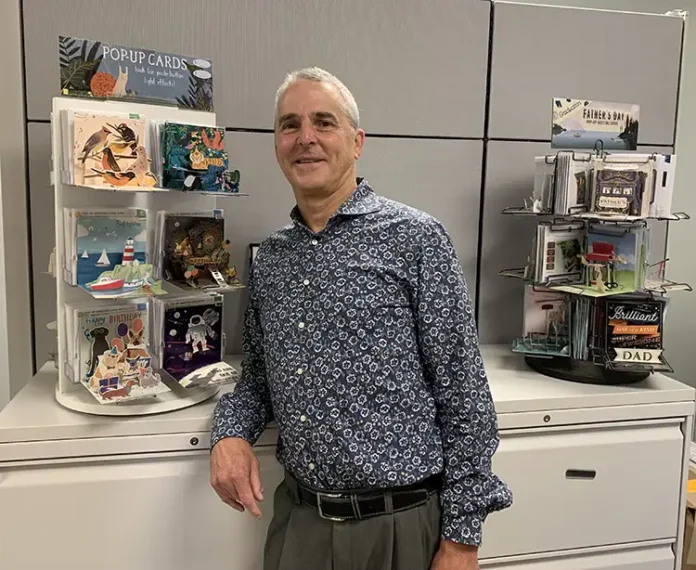George White can make the case for greeting cards in today’s digital world. The greeting card industry veteran has witnessed industry changes over the years to include e-cards, m-cards and social media, but what hasn’t changed is the strong need for more authentic, lasting connections. That’s where greeting cards shine. Sixty-five percent of consumers agree that receiving cards in the mail lifts their spirits. 1 White has spent most of his career making sure those special moments continue.
PostPress recently sat down with White to discuss the challenges facing the greeting card industry and where White sees the industry going in light of a more digital world and sustainability demands.
How did your career develop in the greeting card industry, and what is your role now?
I was hired as the general manager of the Alternative Markets Strategic Business Unit at Gibson Greetings in 1997 – a job for which I had zero experience and less training. But that was the point: The president of Gibson previously had worked with me when I was a consultant on entertainment trading cards, and he wanted someone to bring a fresh perspective to the greeting card industry. Two years later, I was managing all greeting cards at Gibson – and then the company was sold to American Greetings, so I left the industry for a few years.
I then became president of Up With Paper, the original pop-up greeting card company, in 2004, and retain that title today, although my main role now is as CEO of CM Paula, a holding company that owns Up With Paper and three other firms across highly diversified industries. I also have been on the Executive Committee (EC) of the Greeting Card Association (GCA) since 2007, served as president in 2020-21 and will rotate off the EC later this year.
How do you see the greeting card industry embracing global trends, such as the circular economy and sustainability demands from consumers and others?
The most important thing a greeting card can do is to facilitate and/or further the relationship between two humans. That has been and will continue to be the number-one driver in how greeting card makers design and produce their cards, and in the cards consumers purchase.
That said, sustainability is of growing importance for both makers and consumers. We will see accelerating growth in efforts to produce more sustainable cards, such as the use of recycled, alternative or FSC paper for card production; a reduction in the use of non-recyclable polybags or other packaging; an emphasis on more sustainable embellishments; and production and/or processing in net-zero facilities. Europe currently is ahead of the US in this department, and the solutions to more deeply embed the greeting card industry in the circular economy vary dramatically, but adherence to those solutions in the US is accelerating.
What are the biggest challenges the greeting card industry faces? How should the industry respond to successfully grow and thrive?
The obvious challenges are to ensure that retailers of all sizes and types understand how well greeting cards will sell for them – well beyond traditional stationery stores and large grocery and drug stores – AND to combat lazy media stories that greeting cards are no longer relevant. That could not be further from the truth based on the strong sales of cards to millennials.
Frankly, our biggest challenge may well be the health of the US Postal Service, which traditionally has delivered nearly 60% of purchased greeting cards to their final recipient. The rapid price increases, deterioration of service and the inability of USPS to well handle thicker, heavier and odd-sized envelopes with the types of unique cards millennials prefer are combining to make it much more difficult for consumers to send the cards they want to their friends and family. If that continues, it will put a lot of negative pressure on card sales.
It is hard to envision an alternative that can deliver to any household in the US, quickly and at a reasonable price, so our response has to be to halt the negative slide at USPS.
What trends are emerging in the design, production and distribution of greeting cards that will influence the future of the industry?
As indicated, as the influence of millennial consumers continues to grow in our industry, the design, production and distribution of greeting cards will need to continue to change to meet that demand. That means more small and diversified designers and makers; more small-batch production with more embellishments, done more sustainably; and broader and thinner distribution – meaning more stores will carry cards, but with a lower number of cards in each location, with the cards carried matching the customer psychographics of that location.
What are your predictions for the greeting card industry in the next five to 10 years?
The greeting card industry is in a good place. We have a record number of small makers in the industry, and while our largest card buyers by volume, baby boomers, are declining, our largest segment by dollars, millennials, are only now entering their primary card-buying life stages – getting married, having babies and buying a house (not necessarily in that order!) – as they are now 29-42 years old.
I would expect mass-market card sections in Walmart and Kroger stores to get smaller, but the number and variety of retailers carrying greeting cards will continue to expand.
Embellishments will continue to drive sales and pricing as millennials continue to look for differentiated cards that reflect who they are AND their relationship with recipients of their cards.
Overall, I expect greeting card volume to continue a slow decline, but overall greeting card dollar sales to enjoy a slow increase. In short, the next five to 10 years are a good time for small makers, for suppliers able to help them produce unique, differentiated cards for the millennial market and for small retailers who have women customers with money and taste and carry the right greeting cards for them.
Reference
- “Greeting Cards – Facts and Info to Know,” The Greeting Card Association, www.greetingcard.org





